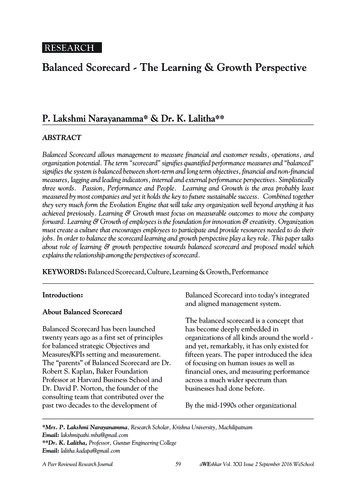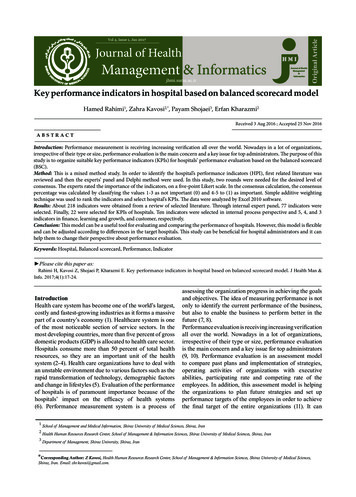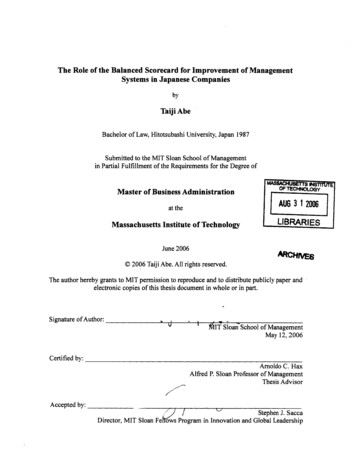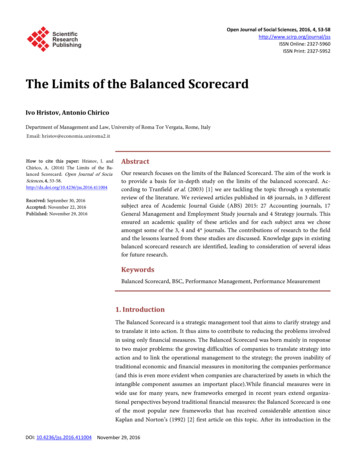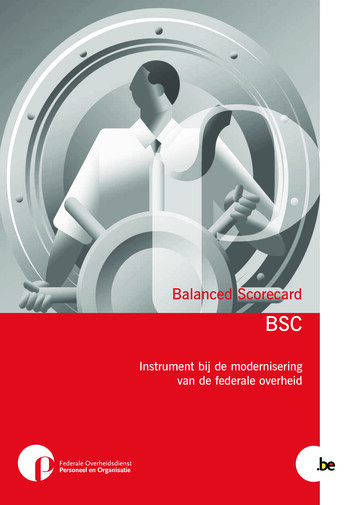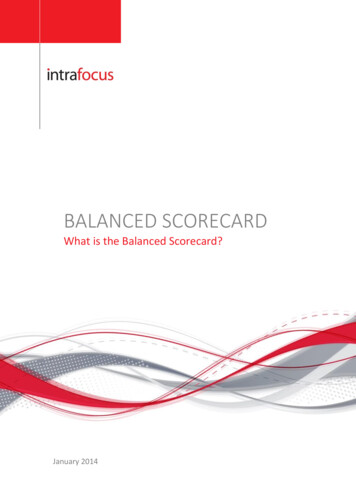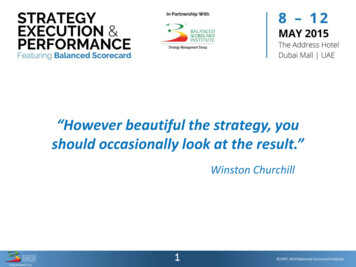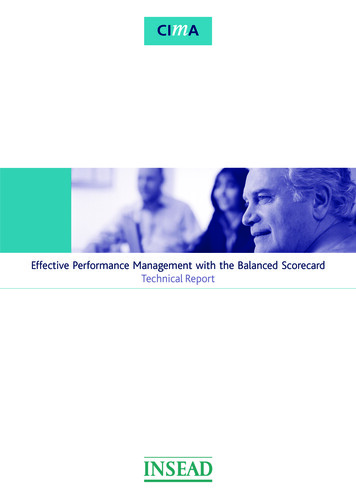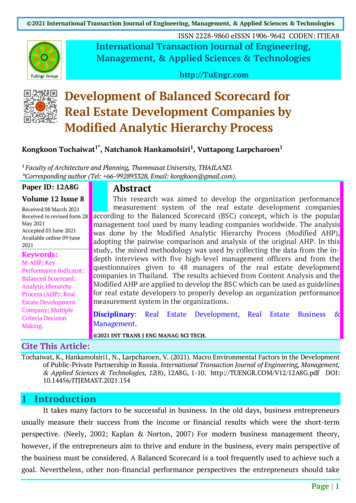
Transcription
2021 International Transaction Journal of Engineering, Management, & Applied Sciences & TechnologiesISSN 2228-9860 eISSN 1906-9642 CODEN: ITJEA8International Transaction Journal of Engineering,Management, & Applied Sciences & Technologieshttp://TuEngr.comDevelopment of Balanced Scorecard forReal Estate Development Companies byModified Analytic Hierarchy ProcessKongkoon Tochaiwat1*, Natchanok Hankamolsiri1, Vuttapong Larpcharoen1Faculty of Architecture and Planning, Thammasat University, THAILAND.*Corresponding author (Tel: 66-992893328, Email: kongkoon@gmail.com).1AbstractPaper ID: 12A8GVolume 12 Issue 8Received 08 March 2021Received in revised form 28May 2021Accepted 05 June 2021Available online 09 June2021Keywords:M-AHP; KeyPerformance Indicator;Balanced Scorecard;Analytic HierarchyProcess (AHP); RealEstate DevelopmentCompany; MultipleCriteria DecisionMaking.This research was aimed to develop the organization performancemeasurement system of the real estate development companiesaccording to the Balanced Scorecard (BSC) concept, which is the popularmanagement tool used by many leading companies worldwide. The analysiswas done by the Modified Analytic Hierarchy Process (Modified AHP),adopting the pairwise comparison and analysis of the original AHP. In thisstudy, the mixed methodology was used by collecting the data from the indepth interviews with five high-level management officers and from thequestionnaires given to 48 managers of the real estate developmentcompanies in Thailand. The results achieved from Content Analysis and theModified AHP are applied to develop the BSC which can be used as guidelinesfor real estate developers to properly develop an organization performancemeasurement system in the velopment,RealEstateBusiness& 2021 INT TRANS J ENG MANAG SCI TECH.Cite This Article:Tochaiwat, K., Hankamolsiri1, N., Larpcharoen, V. (2021). Macro Environmental Factors in the Developmentof Public-Private Partnership in Russia. International Transaction Journal of Engineering, Management,& Applied Sciences & Technologies, 12(8), 12A8G, 1-10. http://TUENGR.COM/V12/12A8G.pdf DOI:10.14456/ITJEMAST.2021.1541 IntroductionIt takes many factors to be successful in business. In the old days, business entrepreneursusually measure their success from the income or financial results which were the short-termperspective. (Neely, 2002; Kaplan & Norton, 2007) For modern business management theory,however, if the entrepreneurs aim to thrive and endure in the business, every main perspective ofthe business must be considered. A Balanced Scorecard is a tool frequently used to achieve such agoal. Nevertheless, other non-financial performance perspectives the entrepreneurs should takePage 1
into account include the customer satisfaction perspective, the internal business processperspective as well as the learning and growth perspective. Apart from the financial aspect, thesefactors should also be considered to help the operators see the risks and chances of businessdevelopment to achieve better financial potential or the company income in the long term. (Kaplan& Norton, 2007; Decharin, 2008).The real estate business is unique in terms of the business process. It is different from otherfields of business. The performance measurement, therefore, is also unique and different fromother types of commerce, whether it is the financial perspective, the customer satisfactionperspective, the internal business process perspective, and the learning and growth perspective.Anyhow, from the literature review, there is no research directly presenting the balanced scorecardfor real estate developers. The researchers are therefore interested in developing such a balancedscorecard by using the Modified Analytic Hierarchy Process (AHP), which applied the pairwisecomparison and analysis of the original AHP to analyze the weights of the Key PerformanceIndicators (KPI’s) of real estate companies.This research aimed to develop a balanced scorecard model for real estate developercompanies in Thailand. The scorecard can be used as guidelines of the organization’s performancemeasurement system that appropriately defines the organizational key performance indicators.2 Scope of the ResearchThe research was scoped to create the models of the organization performance measurementaccording to the concept of the Balanced Scorecard (BSC) for the companies in the real estatedevelopment business in Bangkok, Thailand. The research used in-depth interviews with five highlevel management officers from five companies, who are responsible for determining the businessindicators, as well as the information obtained from the questionnaires given to the 48management officers from 10 real estate companies in Thailand.3 Research MethodologyThis research adopted the mixed methodology by conducting the in-depth interview with 5high-level management officers, who are responsible to set the main key performance indicatorsfor the real estate companies, from 5 different companies to screen the organization performancemeasurement criteria obtained from literature reviews. In addition, the criterion which is suitablefor classifying the real estate development companies into several models were also be inquired.The research quantitative part was performed by distributing the questionnaires to 48 managementofficers from 10 companies who are responsible to set the key performance indicators for variousdepartments of real estate development companies. The Quota Sampling Method was usedaccording to the type of project each real estate development company excels at, such as thecompany expert in the housing projects (house, townhouse, and other types of residences thancondominium) and the company expert in the condominium projects. The results acquired from thequestionnaires were analyzed by using the Modified Analytic Hierarchy Process which establishedthree models of the Balanced Scorecard suitable for each type of company: company excelling athttp://TuEngr.comPage 2
housing projects, company excelling at condominium projects, and the company equally excellingat both types of projects. The data collection was done during June-July 2018.4 Related Theory and Research Results4.1 Balanced Scorecard (BSC)Balanced Scorecard (BSC), developed in 1990 by Professor Robert Kaplan from HarvardUniversity and David Norton, an organization management consultant, is a widely accepted tool formeasuring the success of the organization management. Yet in fact, the Balanced Scorecard is notonly a tool to measure and assess organizational performance, but also a management tool thatleads to efficient strategic management (Kaplan & Norton, 2007; Decharin, 2008). The BSC conceptdiffers from the pre-existing notions that measure the success of business only from the financialperspective because it helps entrepreneurs look at their businesses from various and alldimensions. This concept is widely accepted amongst both academic and business circles. It wasestimated that in 2000, more than 60% of the companies in the Fortune 1000 use BSC as theirsuccess indicators (Gawankar et al., 2015).According to the BSC concept, the organization performance measurement must be donethrough 4 perspectives including (1) financial perspective, (2) customer perspective, (3) internalbusiness process perspective, and (4) learning and growth perspective. There are 7 steps to developthe BSC including (1) define the elements of the scorecard, (2) identify the performance drivers, (3)identify the performance measures, (4) communicate about the importance of BSC, (5)operationalize, (6) train, and (7) monitoring, evaluation and review (Gawankar, Kamble& Raut,2015).4.2 Key Performance Indicator (KPI)The performance indicator is the measurement of work results that help the members of theteam or the organization precede in the same direction. It is also an instrument to assure that theorganization members focus their time and work on the important factors for organizationalsuccess. A good Key Performance Indicator (or Key Performance Index) must be right in the amountand select from various factors but emphasizes only on the values that will indicate theorganizational success, and cross out the unimportant factors or the normal activities of theorganization. It must also be simple and aims to achieve good teamwork. The indicator should alsohave certain significant effects on the target or organizational success (Parmenter, 2015). Theobjectives or the factors to be measured must be determined first, then the indicators can beidentified to measure the objectives according to the strategic map (Decharin, 2008).4.3 Modified Analytical Hierarchy Process (Modified AHP)4.3.1 Concept of Analytical Hierarchy Process (AHP)Analytical Hierarchy Process (AHP) is a method to analyze and find the best solution oroption by applying various criteria and dimensions (Wuttiwanit, 2003; Vargas, 2010). The AHP wasfirst implemented in the year 1980 by Thomas Saaty from the University of Pennsylvania in thehttp://TuEngr.comPage 3
United States of America. It is nowadays an accepted and widely used technique due to itsefficiency for decision-making for complicated issues. There are also multiple criteria for thedecision making which helps the persons in charge prioritize each factor until the best outcome isachieved (Saaty, 2005).The prominent points of the Analytical Hierarchy Process (TransparentChoice.com, 2021)are such as: (1) It is a proved theory. In the past decades, AHP was tested and practiced bythousands of organizations worldwide. In the present days, there are many studies explaining aboutwhy several well-known companies choose the AHP for strategic decision making for betteroutcomes. (2) It is easy to apply. The AHP users are able to divide complicated decisions intoobvious goals and criteria which can be prioritized and estimated, making the process andcomprehension much easier. (3) It is designed especially for the decision making of various criteria.For example, in order to achieve the best product and make profit at the same time, two criteria,“cut the cost” or to “maximize the product quality”, are in conflict, have the same importancelevel, and need to be taken into account. This is where the AHP plays a significant role to helpconsider all criteria and prioritize them in hierarchical order. (4) It helps the team compromise andachieve a consensus. The team members can give different opinions according to their perspectivesand expertise and all these notions will matter. Compromising and consensus are thereforeachieved from various options.The steps of the Analytical Hierarchy Process begin with setting a goal of the decisionmaking (about what to decide), then the criteria for such decision making must be established.There can be more than 1 criterion (primary and secondary criteria). Then they will be estimated toaccomplish the best option by processing and prioritizing, as shown in Figure 1.Figure 1: Example of Criteria and Alternatives HierarchyOnce we obtain the criteria for decision making, we can continue to do the pairwisecomparison and use the results to calculate the value of importance. The best score (bycomparison) after the calculation refers to the best alternative.4.3.2 Modified Analytical Hierarchy ProcessMany researchers apply the Modified Analytical Hierarchy Process to better respond to theresearch objectives. Examples of such research works include those of Kallas (2011) and Tochaiwathttp://TuEngr.comPage 4
& Likitanupak (2012) which used the Likert Scale instead of the pairwise comparison to reduce thenumber of questions. As well as the work of Tochaiwat et al. (2017) which used the pairwisecomparison of the Analytical Hierarchy Process to calculate and figure out the factor weights of themodels for the selection of land for residential development projects as𝑌𝑌 𝑎𝑎1 𝑋𝑋1 𝑎𝑎2 𝑋𝑋2 𝑎𝑎3 𝑋𝑋3 𝑎𝑎𝑛𝑛 𝑋𝑋𝑛𝑛(1).Where Y is the score for the decision to choose the alternatives compared by the analyst.𝑎𝑎1 , 𝑎𝑎2 , 𝑎𝑎3 , , 𝑎𝑎𝑛𝑛 are the coefficients displaying the importance of each criterion for thedecision-making numbers 1, 2, 3, 𝑛𝑛, respectively.𝑋𝑋1 , 𝑋𝑋2 , 𝑋𝑋3 , 𝑋𝑋𝑛𝑛 are the rating (1 to 5) for the criterion 1, 2, 3, , 𝑛𝑛 of each alternativebeing compared, respectively.This research selects the Modified Analytical Hierarchy Process similar to the one ofTochaiwat et al. (2017) where the process is completed only when the weights of all criteria arefigured. Both primary and secondary criteria must be evaluated without any decision to choose aspecific alternative (organization), hence no option should affect such decision. As a result, thediagram showing the hierarchical order of the analytical process will only display Hierarchy 1 Goal,and Hierarchy 2 Criteria (Primary and Secondary), as shown in Figure 2:Figure 2: Hierarchy of the Research Analytical Process.5 Analysis and ResultsThis research was conducted from the related literature reviews and interviews with 5experts who are the high-level management officers of real estate development companies. Thepersonal details of each informant are listed in Table 1. After analyzing the acquired data, thehttp://TuEngr.comPage 5
researchers concluded the key performance indicators (KPIs) which affect the success of thecompanies according to 4 perspectives of the Balanced Scorecard Theory as shown in Table 3.Table 1: Summary of the Informants’ DetailsCompanyPositionExperienceABCDEManaging DirectorChief Executive OfficerManaging DirectorChief Financial OfficerChief Financial Officer4 Months3 Years1 Year22 Years3 YearsCompany Registered Capital(Million US Dollar)*35.2342.647.263.0384.7Table 3: Summary of Key Performance Indicators (KPIs) obtained from this study’s in-depth interviews withthe experts.PerspectiveFinancial PerspectiveCustomer PerspectiveInternal Process PerspectiveLearning and Organizational GrowthPerspectiveKey Performance Indicator (KPI)1. Net Profit Margin2. Gross Profit Margin3. Capital Management Efficiency4. Revenue5. Sales1. Overall Satisfaction of Customers2. Ratio of Customer Referral to Other Customers3. Number of Complaints1. Amount of Frauds in the company2. Number of Walk-in Customers of the Project3. Ratio of the Residence Delivered on Time4. Continuation in Operation1.Number of Training for Each Staff2. Overall Staff Satisfaction3. Evaluation of Staff SkillIn this research, the researchers divided the types of residences into 2 categories which arethe housing projects (houses and townhouses) and the condominium projects and categorized realestate development companies into 3 groups: (1) the companies majorly invest in housing projects,(2) the companies majorly invest in condominiums, and (3) the companies invest in both types ofprojects in general (not specific of type). Then, each type of company was prioritized theimportance from each perspective of the BSC by using the Modified AHP, as shown in Table 4.Table 4: Importance of Four PerspectivesPerspectivesFinancial PerspectiveCustomer PerspectiveInternal Process PerspectiveLearning and OrganizationalGrowth PerspectiveTotalCompany Majorly Invests inHousing Projects59.2020.8012.407.60100.00Weight of Importance (in Percentage)Company Majorly Invests inCompany Equally Invests inCondominium ProjectsBoth Housing andCondominium .00100.00From the research results, among 4 perspectives of the BSC, the financial perspective stillseems to matter the most in determining the company’s success level. Other perspectives, e.g.customer perspective, internal process perspective, and learning and growth perspective, seem tohttp://TuEngr.comPage 6
respectively have less significances. This finding can be universally applied for all types of realestate companies, whether it is the housing, condominium, or both in general.Since it is essential for every organization to have the success indicators considered from all4 perspectives according to the BSC to achieve a balanced performance, the researchers thereforeestablish an additional analysis of the importance value of each key performance indicator, whichcontribute to the organizational scorecard (see Table 5).Table 5: The Balanced Scorecard for Real estate Development CompaniesPerspective/KPIFinancial PerspectiveNet Profit Comparing to TargetGross Profit Comparing to TargetCurrent Ratio Comparing to TargetRevenue Comparing to TargetSales Comparing to TargetReturn of Asset Comparing to TargetCustomer PerspectiveSatisfaction Rating for Product(Residence) Comparing to TargetSatisfaction Rating for BrandComparing to TargetSatisfaction Rating for Sale and AfterSale Services comparing to TargetSatisfaction Rating for the Project ImageComparing to TargetRatio of Customer Recommendation toOther Customers Comparing to TargetNumber of Complaints Comparing toTargetInternal Process PerspectiveAmount of Fraud in the CompanyComparing to TargetNumber of Walk-ins Comparing toTargetRatio of Residence Delivered on TimeComparing to TargetAverage Duration of Time from the Saleto the Ownership Transfer Comparingto TargetAverage Duration of Construction per 1unit Comparing to TargetLearning and Growth PerspectiveNumber of Training per StaffComparing to TargetStaff Satisfaction in General Comparingto TargetStaff Turnover Rate Comparing toTargetRating of Staff Working Skill Evaluationby the Supervisor Comparing toTargethttp://TuEngr.comCompany Majorly Investsin Housing ProjectsWeight of Importance (in Percentage)Company Majorly Invests inCompany Equally Invests inCondominiumBoth Housing andProjectsCondominium Projects% in the% in the Model% in the% in .96% in 0.0030.08% in 001.3314.471.1015.721.9812.321.17Page 7
From Table 5, it can be concluded that the Balanced Scorecard for real estate developmentcompanies in Thailand consists of 3 scorecards as shown in Equations 2 to 4:(1)The real estate development companies majorly invested in the housing projects,Y 0.592 (Fin) 0.208 (Cus) 0.124 (Pro) 0.076 (Lrn)(2)(2).The real estate development companies majorly invested in the condominiumprojects,Y 0.372 (Fin) 0.348 (Cus) 0.154 (Pro) 0.126 (Lrn)(3)(3).The real estate development companies equally invested in both housing andcondominium projects (or in case of unclear data about the investment portfolio),Y 0.515 (Fin) 0.255 (Cus) 0.136 (Pro) 0.094 (Lrn)Where Y(4). Percentage of Achievement in General (%)Fin Percentage of Financial Achievement (%)Cus Percentage of Customer Satisfaction Achievement (%)Pro Percentage of Internal Process Achievement (%)Lrn Percentage of Learning and Growth Achievement (%)The percentage of each perspective’s achievement can be calculated from the KPIs, such as,the percentage of learning and growth achievement of the real estate development companies whoare more invested in condominium projects can be calculated by the equation: Y 0.2960(achievement percentage on number of trainings) 0.3317 (achievement percentage on staffsatisfaction) 0.2151 (achievement percentage on staff turnover rate) 0.1572 (achievementpercentage on staff working skill).For example, the Company A, who is equally good at both housing and condominiumprojects, has the percentages of financial achievement, customer satisfaction achievement, internalprocess achievement, and learning and growth achievement in the past year as follows: 105%, 80%,60% and 70%, respectively. The company’s general achievement score is 0.515 (105%) 0.255 (80%) 0.136 (60%) 0.094 (70%) 0.8922 or only 89.22%, even though the company has better financialperformance than its goal.6 ConclusionFrom this study, a balanced scorecard is a necessary and effective tool to measure thesuccess level of a company. Apparently, it can be notified that the financial perspective has thegreatest effect on business success.Financial success, hence, is one obvious short-termaccomplishment, while other perspectives such as learning and growth take much more investmentof money and time and can only be continuously progressed in major organizations or companies.The customer satisfaction, the internal process, and the learning and growth perspectives seem tohave respectively less important in accordance with their relationships with the financial success ofhttp://TuEngr.comPage 8
the organization. However, they should not be neglected by the organization management becausethey finally contribute to financial success.Financial success occurs when customers are sosatisfied that they decide to buy residences from the companies.Customer satisfaction isgenerated by the internal processes of the organizations. Finally, the learning process and growthprocess enhance staff’s competencies in performing internal processes effectively. In addition, thecompanies majorly invest in condominium projects seem to have less gap between financialperspective and customer satisfaction perspective than other types of companies. This reflects thehigher competition in the condominium industry than in the housing industry. The results matchwith other studies stating, for example, that the financial indicators have relationships with thecompany’s stock price as well as the corporate credit rating (Khunjan, 2009; Prapatwimol et al.,2013).Finally, the researchers would like to suggest those who are interested in performing afurther study by considering the effects of some factors that affect the indicators or the importancevalues of the indicators into the scorecard. These factors consist of the internal factors of realestate companies such as products’ price ranges or competitive strategies, as well as the externalfactors, such as political factors or economic condition factors, as mentioned by Buathong &Bangchokdee (2015) that the different situations affect the organizational scorecard.7 Availability of Data and MaterialData can be made available by contacting the corresponding authors.8 ReferencesBuathong, S. & Bangchokdee, S. (2015). Use of Financial and Non-financial Performance Measures withinContingency Theory. Journal of Accounting Profession, 11(31), August 2015, 63-79.Decharin, P. (2008). Implementing Balanced Scorecard. 6th ed. Bangkok: Chulalongkorn University Press.Gawankar, S. & Kamble, S. & Raut, R. (2015). Performance Measurement using Balance Score Card and itsApplications: A Review. Journal of Supply Chain Management System, 4 (3), 6-21.Kaplan, R.S. & Norton, D.P. (2007). Using Balanced Scorecard as a Strategic Management System. HarvardBusiness Review – Managing for the Long Term, 2007(July-August): 96-109.Khunjan, K. (2009). Relationships between Financial Indicators and Stock Price: A Case Study of ListedCompanies in the Stock Market of Thailand. Master’s Degree Independent Study, Kasetsart University,Faculty of Business Administration.Prapatwimol, N., Hensawang, S. & Javakorn, J. (2013). The Relationship between Financial Indicators, CorporateGovernance and Company Credit Rating of the Listed Company in the Stock Exchange of Thailand. Proc.of The 3rd National Conference of Sri-Ayutthaya Rajaphat University Group (NCSAG 3), Phatum Thani,14-15 February 2013.Neely, A. (2002). Business Performance Measurement :Theory and Practice.Cambridge: Cambridge UniversityPress.Parmenter, D. (2015). Key Performance Indicators: Developing, Implementing, and Using Winning KPIs. 3th Ed.,John Wiley & Sons.Saaty, T.L. (2005). Theory and Applications of the Analytic Network Process: Decision Making with Benefits,Opportunities, Costs, and Risks. Pittsburgh: RWS Publications.http://TuEngr.comPage 9
TransparentChoice.com. (2021). ing?.RetrievedJan2021,Vargas, R.V. (2010). Using the Analytic Hierarchy Process (AHP ) to Select and Prioritize Projects in a Portfolio.Proc. PMI Global Congress 2010- North America, hold by Project Management Institute, Washington DC,9-12 October 2010.Wuttiwanit, W. (2003). Decision Making by Analytic Hierarchy Process. Chonlakorn, 57-76.Dr.Kongkoon Tochaiwat is an Associate Professor at the Faculty of Architecture and Planning, Thammasat University,Thailand. He received Ph.D. in Civil Engineering (Construction, Engineering and Management) from ChulalongkornUniversity, Thailand. His research focuses on Real Estate Business and Development.Natchanok Hankamolsiri is a Master’s Degree graduate from Innovative Real Estate Development Program atthe Faculty of Architecture and Planning, Thammasat University. She received Bachelor’s Degree fromKasetsart University.Dr.Vuttapong Larpcharoen is an Assistant Professor at the Faculty of Architecture and Planning, ThammasatUniversity, Thailand. He got a Doctor of Management degree. His research is Marketing Management.http://TuEngr.comPage 10
4.1 Balanced Scorecard (BSC) Balanced Scorecard (BSC), developed in 1990 by Professor Robert Kaplan from Harvard University and David Norton, an organization management consultant, is a widely accepted tool for measuring the success of the organization management. Yet in fact, the Balanced Scorecard is not
